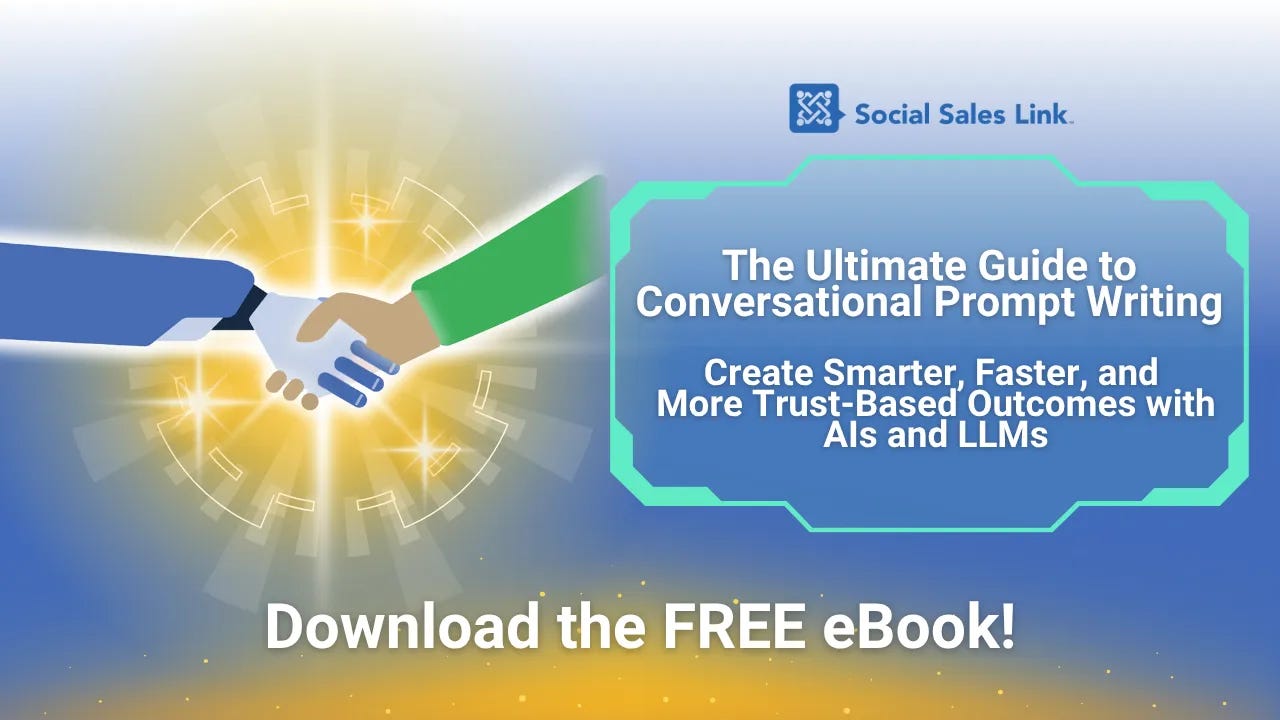In Sales, The Hard Path is the Best Path
Why the most meaningful work in sales rarely comes from shortcuts
The TL;DR (Executive Summary)
A recent moment on Making Sales Social LIVE surfaced a truth I’ve seen play out for years: the people we serve at Social Sales Link consistently choose the harder, more intentional path.
The hard path is not defined by effort. It is defined by clarity, curiosity and relevance.
This approach might feel slower, but it works better, lasts longer and creates stronger, trust-based outcomes.
The harder path is both a philosophy and a system; a way of working that turns intention into results.
Where This Started
In prepping for our recent Thanksgiving-themed episode of our Making Sales Social LIVE podcast about what we’re all thankful for, I created a line that surprised me the moment I typed it in. It’s something I never really thought about before, especially when it comes to our community of clients here at Social Sales Link, but it is 💯 true:
“The people we serve choose the harder, better path.”
I kept thinking about that line, not because it sounded good, but because it distilled something I’ve observed for years but never really thought about until then. The individuals who gravitate toward our work aren’t looking for shortcuts or hacks. They’re looking for substance. They’re looking for a way to build a sales practice they can stand behind… proudly.
In other words, they’re looking for what social selling really is: a relationship-focused strategy and system that fosters trusted, value-centric conversations, rather than just a sales tactic. Social selling is a human-centric skill that uses technology to facilitate genuine interactions and help buyers make informed decisions, rather than just aggressively pushing a product.
In a digital landscape that celebrates speed and scale, that harder choice is becoming increasingly rare. It’s because of that rarity that it’s increasingly important, too.
What Makes the Hard Path Hard
The more challenging path isn’t difficult because it demands more effort. It’s difficult because it demands more intention … and especially nowadays, the opposite of intention is what gets rewarded on social media, etc.
Choosing that harder path requires:
Slowing down in a system designed for acceleration.
Instead of blasting cold messages or relying on automation, you take the time to observe, think and respond with purpose.
Prioritizing conversation over performance.
You don’t treat every interaction as a broadcast. You treat it as an exchange between people who might actually help one another.
Focusing on relevance instead of reach.
It’s easier to appear everywhere than to matter somewhere. The harder path insists on the latter.
Showing up as a person rather than a persona.
A script can generate activity. Only a human being can build trust.
None of this is complicated. But it is uncommon. And that is what makes it hard.
Why the Hard Path Works Better Than the Easy One
The harder path often feels slower in the moment; more thoughtful, more measured, more deliberate. But the results tend to arrive faster and with greater stability. Here’s why:
Trust accelerates decisions.
People move more confidently when they believe the person across from them is acting with integrity.
Relevance creates clarity.
Tailored insights remove confusion. Clarity shortens the gap between interest and action.
Consistency builds reputation.
Anyone can create noise. Very few can demonstrate reliability.
Value compounds.
The harder path produces work that continues to benefit you long after the initial effort is made.
Shortcuts create bursts of activity that fade almost immediately. Intention, on the other hand, produces momentum that continues to grow.
Why I Admire the People We Serve
This was the real insight from that MSS LIVE moment.
The people we serve are not trying to game the system. They are trying to elevate their craft. They want to make meaningful contributions, have meaningful conversations, and create meaningful opportunities.
They want:
depth, not volume.
precision, not performance.
genuine interaction, not transactional motion.
something they can be proud of, not something they can simply automate.
These are the individuals who choose to build instead of blast. They pursue progress, not shortcuts. And when they share a win, even if it’s a small one, it feels like a shared victory, because we know the intention behind it.
The Harder Path Is a Philosophy… and a System
It’s easy to think of the harder path as a mindset, but it’s much more than that. It becomes a rhythm, a structure, and a system that guides how you approach your work.
The system relies on a few core principles:
Start with curiosity. Let genuine interest guide your attention.
Lead with what is relevant. Relevance is the strongest expression of respect.
Give before you request. When value comes first, trust follows naturally.
Earn each step forward. Not through pressure, but through presence.
This is what it looks like when a philosophy becomes a practice. It’s when intention is translated into behavior, and behavior into outcomes.
What’s more, choosing the harder, more intentional path becomes a form of leadership. It becomes a signal of what you stand for. And in the long run, it becomes the reason your work continues to matter.
Would love to discuss all of this in the Comments section below!
Want to know what can help you down that path? Artificial intelligence (AI) and large-language models (LLMs). Our FREE Ultimate Guide to Conversational Prompt Writing eBook enables you to ignite smarter conversations. By shifting our mindset to see AI as a thinking partner and not just a content creator, we open the door to deeper insights and innovative ideas that can enhance trust in our business relationships.
NOTE: Google Gemini’s Nano Banana Pro generated the hero image for this post.




I love the methodical measured approach vs the shotgun approach. Being intentional in growing relationships and your business is the key.